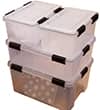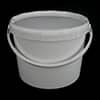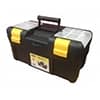People have relied on rainwater to sustain life since time immemorial, with the first evidence of a viable running water system dating from the Roman Empire between 27BC and 476AD.
With today’s public water network serving 99% of the UK population, you could be forgiven for thinking there’s no use for the good old fashioned water butt, but (excuse the pun!) you’d be wrong, as they still offer benefits for people and the environment.

© Olya Detry / Shutterstock.com
A poll by the Wildfowl and Wetlands Trust reveals around one-third of UK householders have installed a water butt due to growing concerns about water usage, with internet searches for “rainwater harvesting” increasing by 200% since 2018.
What is rainwater collection?
Rainwater collection, also known as water harvesting, goes back thousands of years to when people first started farming the land. The first documented evidence dates from 2500BC in Israel, where the remains of an ancient clay-lined cistern carved in rock were unearthed.
A similar cistern to collect rainwater, dating from around 1700BC and with a capacity of more than 2,400 cubic feet, was found on the island of Crete. In Thailand, residents have been collecting rainwater into pots and jars from gutters and roofs since around 100BC and the practice continues today.
The Ancient Romans were the first society to create a system of water distribution to people’s homes and public baths using aqueducts fed by springs, groundwater and surface water. The system provided each household in Rome with around 84 gallons of water per day - the amount supplied in today's cities.
When was the water butt invented?
Individual householders wishing to collect, store and use rainwater didn’t have anything as large or elaborate as the cisterns and aqueducts of ancient civilisations. They used simple containers in the garden to collect rainwater.
The term “water butt” first appeared in 1726, when it was coined by English author George Shelvocke. It was derived from an old English word, “butte”, meaning a barrel or similar container.
People tried a variety of methods to purify the water, including heating it up in the sunshine and filtering it through sand or charcoal in cisterns. Filtering water in this way is still used in parts of the world where the supply is untreated. Eventually, rainwater was boiled over fires while people cooked to remove impurities and kill bacteria.
Great advances in science since the mid-19th century have led to safe drinking water across much of the world, especially since the dawn of water treatment plants. However, in the 21st century, there has been renewed interest in old-fashioned water butts as a sustainable way of collecting and storing rainwater.
Why are more people storing water?
A survey commissioned by UK charity the WWT revealed growing concerns among the public about water usage. Fears of climate change causing water shortages due to hotter and longer summers affected 65% of respondents, who wanted to know how empty their local reservoirs were.
Parts of England have already experienced spasmodic problems with water shortages since 1995, with the latest episode being in 2022, when there was a lack of running water in some regions. A combination of droughts, low river flows and high temperatures were cited as the reason. In addition, as the population grows, the demand for water is increasing, while a staggering three billion litres of water are lost to leaks every day.
The survey found more than 40% of Brits either had a pond filled with rainwater, or were considering installing one. Almost half would consider creating a ditch with the appropriate plants that could be filled naturally with rain.
Benefits of water butts
People are using water butts today as a more sustainable way of living, as storing rainwater can help to reduce our reliance on mains water. It has various uses, such as watering plants and topping up garden ponds.
Studies suggest rainwater can be better than treated tap water for watering plants, including fruit and veg, as it’s more organic. Collect rainfall in winter and store it ready for spring and summer, particularly if there’s a long, hot, dry spell or a drought forecast.
People on metered water can save money by collecting rainwater to use at home. Experts estimate a rainwater collection system can save between 40% and 50% on bills by using it for the washing machine, garden irrigation, washing the car, flushing the toilet and more.
WWT chief executive Martin Spray says installing a water butt can also reduce the pressure on storm drains. However, more than 50% of respondents feel their local council or water company should offer a subsidised rainwater container to householders.
Storing water can reduce carbon emissions. Electricity is required to collect, treat and pump mains water to our homes and businesses, so using rainwater creates a lower carbon footprint, with a gravity-fed pumping system using the least power. Every 1,000 cubic metres of rainwater used saves 285kg of carbon dioxide in processing terms.
How do you keep rainwater fresh?
Keep collected rainwater fresh to ensure it doesn’t become stagnant or carry diseases by storing it in a closed container and keeping downspouts and gutters clean to prevent debris from entering. It’s best to keep it out of direct sunlight, as this can fuel the growth of algae.
An effective filtering system is a must to remove debris and sediment, such as a first-flush diverter and mesh screens. Check the water butt regularly to look for any signs of microbial growth, stagnation or odours and clean immediately if any are present.
Treat the water regularly with an appropriate disinfectant or UV sterilisation and use a food-grade liner. Test the water periodically with a purpose-made water quality testing kit.
DIY water butt
Our 220-litre air and watertight heavy-duty plastic storage drum is manufactured from chemical-resistant food grade HDPE, making it suitable for drinking water. The removable lid is fitted with a gasket and band closure to ensure a strong seal, and it can store contents at a temperature of between -40°C to +60°C, so it’s suitable for use in all weather extremes.
Our 100-litre black plastic industrial catering bin with lid is from our market-leading range of high grade bins unique to Solent Plastics. Made with a black EPDM base and PP lid, it makes the perfect water butt for commercial or home use. Able to withstand temperatures ranging from -10°C to 80°C, it features heavyweight impact-resistant construction, with a flat drop-on lid for safe water storage – the lid is vital to prevent wildlife fatalities.
The Renewable Energy Hub believes the primary benefit of storing rainwater is to reduce our impact on the environment and suggests that in future, all new-build homes should have their own rainwater harvesting system as part of a new generation of green technology.





























































